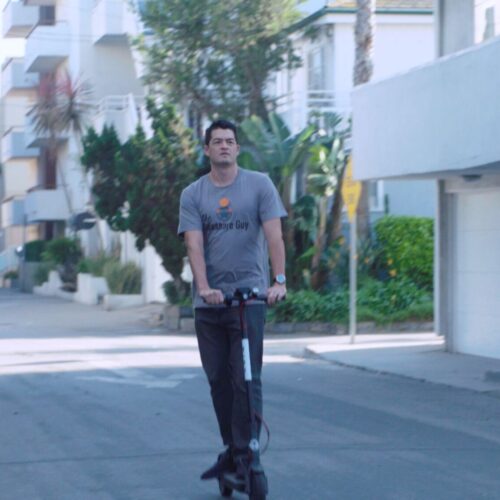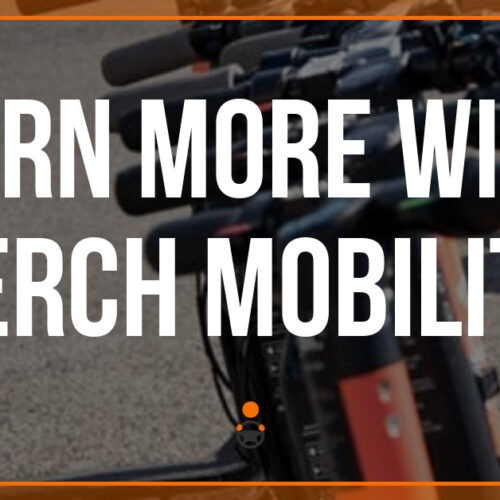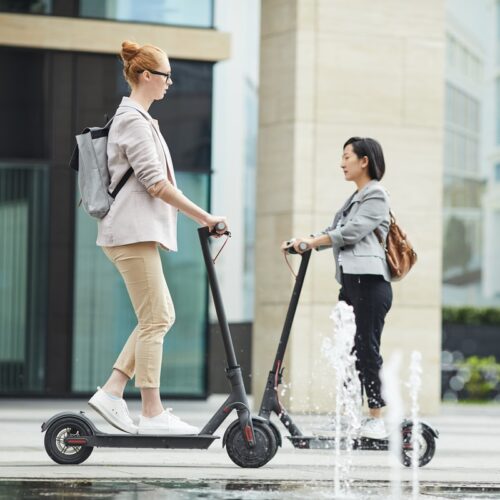Quick Links:
- Click here to download the Bird app and get a free ride
- Click here to become a Bird Charger
- Click here to become a Bird Mechanic
- Join our forum for chargers
- If you’re interested in becoming a Bird charger, then you might also be interested in these gig economy jobs.
The scooter craze, particular Bird scooters, is really heating up – and doesn’t show signs of stopping. Luckily, as a new industry, there are still plenty of opportunities for you to make money as a Charger – if you know what to do. In this article, RSG contributor-at-large Ezra Dubroff covers what it’s like to work as a Bird Charger, what to look for, and opportunities for Bird Chargers.
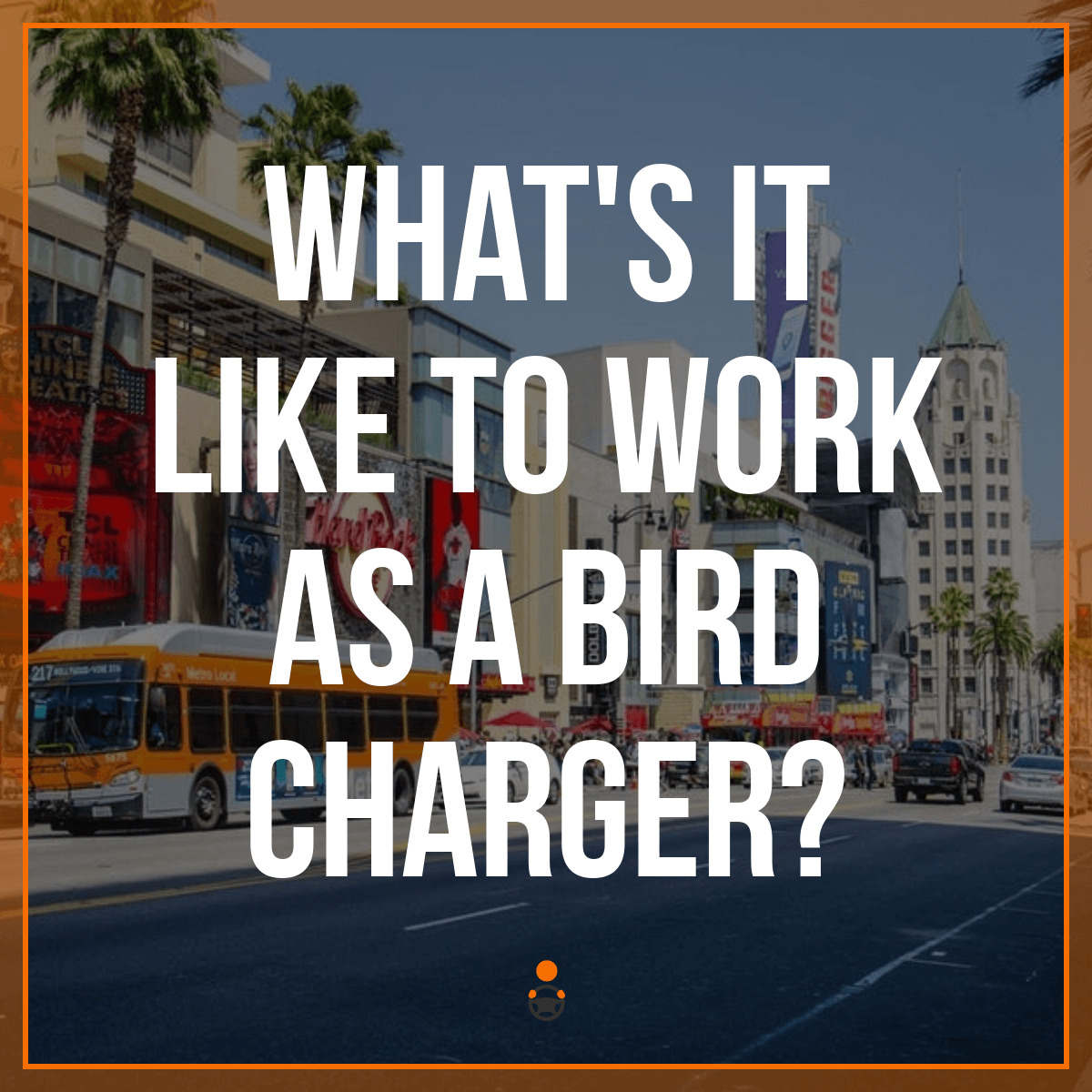
Has the electric scooter craze hit your city yet? If it has, you’ve probably noticed a bunch of them zipping by or maybe parked around town. If “the scooters” aren’t in your city yet, they’re probably coming soon.
The scooters I’m writing about are of course the dockless, electric version, with apps like Bird, Spin and Lime allowing riders to rent by the minute and go wherever their range will allow. In order for these services to flourish though, they rely on an army of on-demand workers to hunt them down, re-charge them and release them in the mornings. With the Bird app, the workers are called Chargers and use an app to locate Bird scooters (aka Birds).
Depending on factors including battery level, time of last ride and distance from service area, each Bird will be assigned a dynamic value, generally between $5 and $20. That value represents the amount a Charger will be paid to locate that Bird, retrieve it, charge it fully and release it the next morning at a location in the local service area.
In this post, we’ll dive a bit deeper as I share my experiences of being a Bird Charger over a number of months, and we’ll examine a bunch of cool stuff including my successes, failures, earnings and expenses.
So hop on and let’s go… But please remember, only one rider per Bird and always wear a helmet!
Want these tips in a handy checklist? Download our 10 Pro-Tips for New Bird Chargers below:
Bird huntin’ in Los Angeles
I live in Los Angeles, California, close to Santa Monica, where Bird first launched in 2017.
Within a few days of my first ride, I was signing up to be a Charger so that I could earn money for charging Birds.
Full disclosure: In addition to being a Charger, I now also work with Bird to help make the Charger program better for workers by sharing my experiences and suggesting improvements.
After completing my onboarding, I was shipped three power supplies so that I could get started charging Birds. Then it was time to go find some Birds.
Related article: essential gear every scooter charger should have
Finding Birds to Charge
Something to keep in mind: Your success as a Charger is closely tied to how quickly and easily you can find Birds.
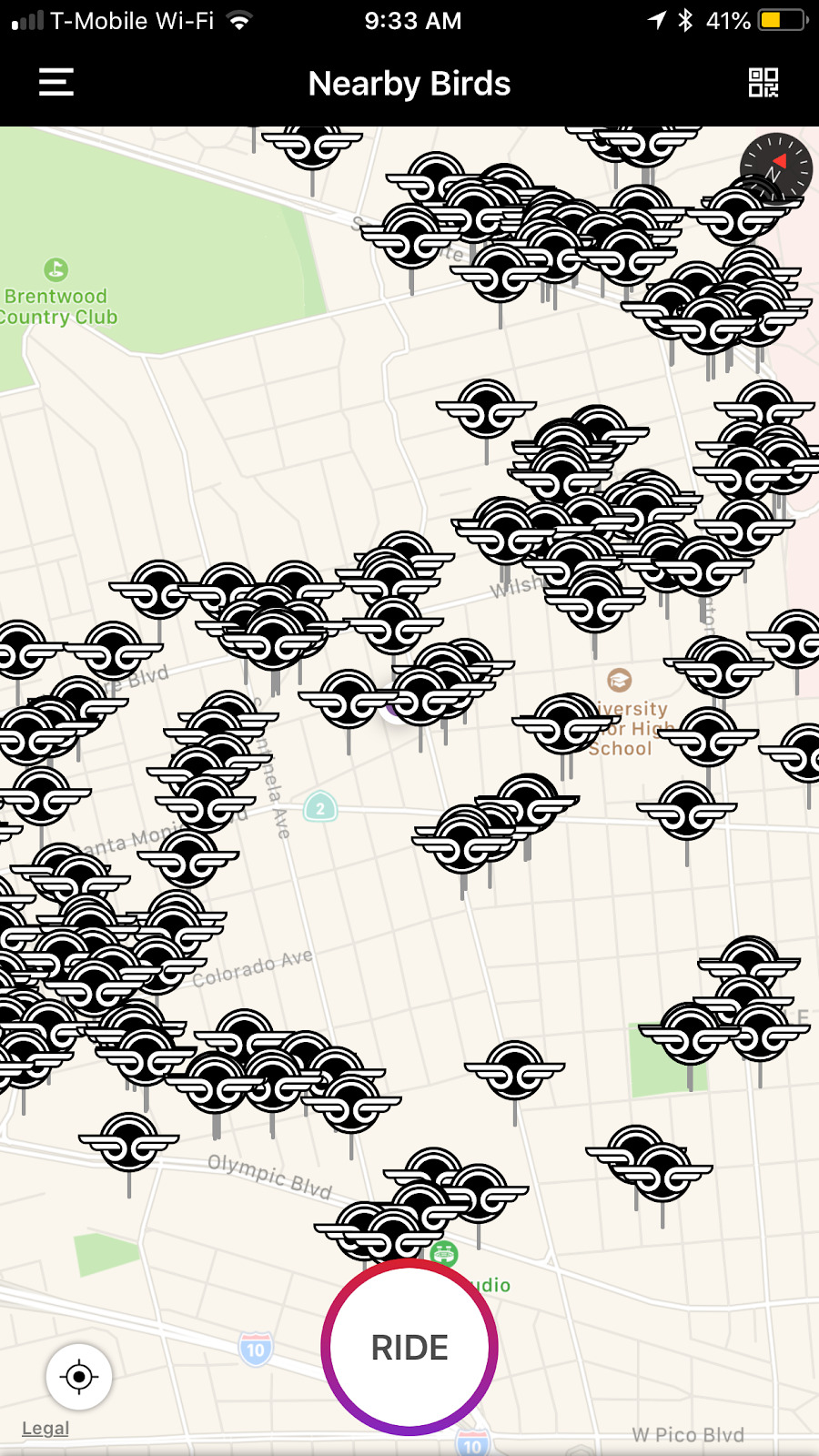
Since I live within a Bird service area, I first set out to look for Birds that appeared on the map nearby. Like a lot of new Chargers, I was drawn to the high-value Birds and I tried to find a $20 Bird that the map indicated was in a small sushi takeout restaurant but this was a mistake.
I got to the location, but couldn’t locate the Bird. Immediately, everyone became a suspect: the cook, the cashier and the customer in line… Who was hiding the Bird? In reality, that Bird was probably long gone.
You see, the scooters’ tracking information is only accurate and recent to some degree. Sometimes Birds can be moved from a location yet still appear there on the Charger map. This is why it’s important to also look at the last ride and last location data to determine if a Bird will likely be where the map says and if it’s worth the time to look for it.
Want to chat with other Chargers about strategy? You can joinour group here.
To any of you who’ve used the Charger app before, the examples below might seem odd. A Bird with a recent ping valued at a high $14, while a Bird that hadn’t phoned home in 3 days valued at only $5. Well, I’ve learned the Bird algorithm works in mysterious ways, but there must be something to it, right?
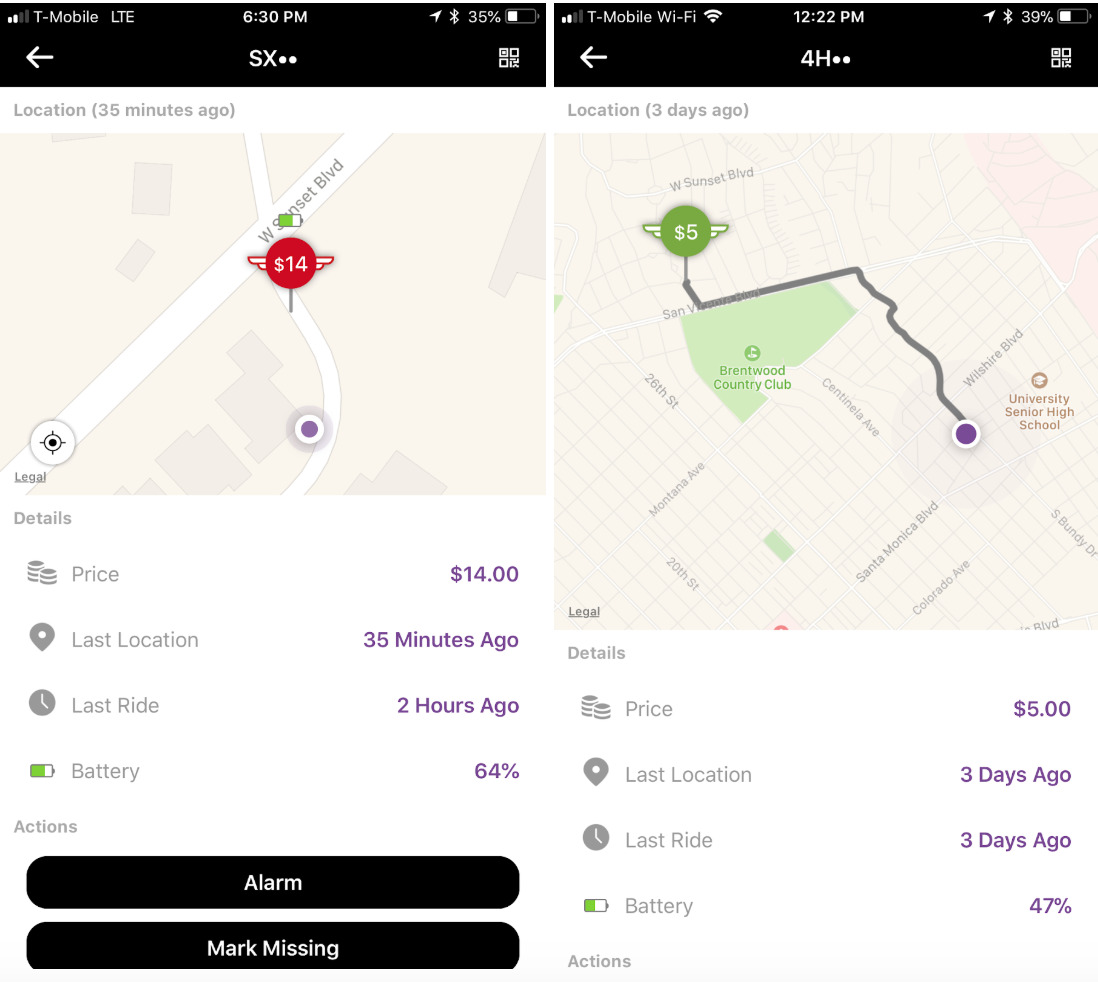
Pro tip: The current version of the Charger app for iPhone shows location and ride data detailed to the minute or hour (e.g. “3 Minutes Ago,” whereas with Android, it will only display to the day (e.g. “Today.”) This gives iOS users a bit of an advantage in choosing which Birds to look for.
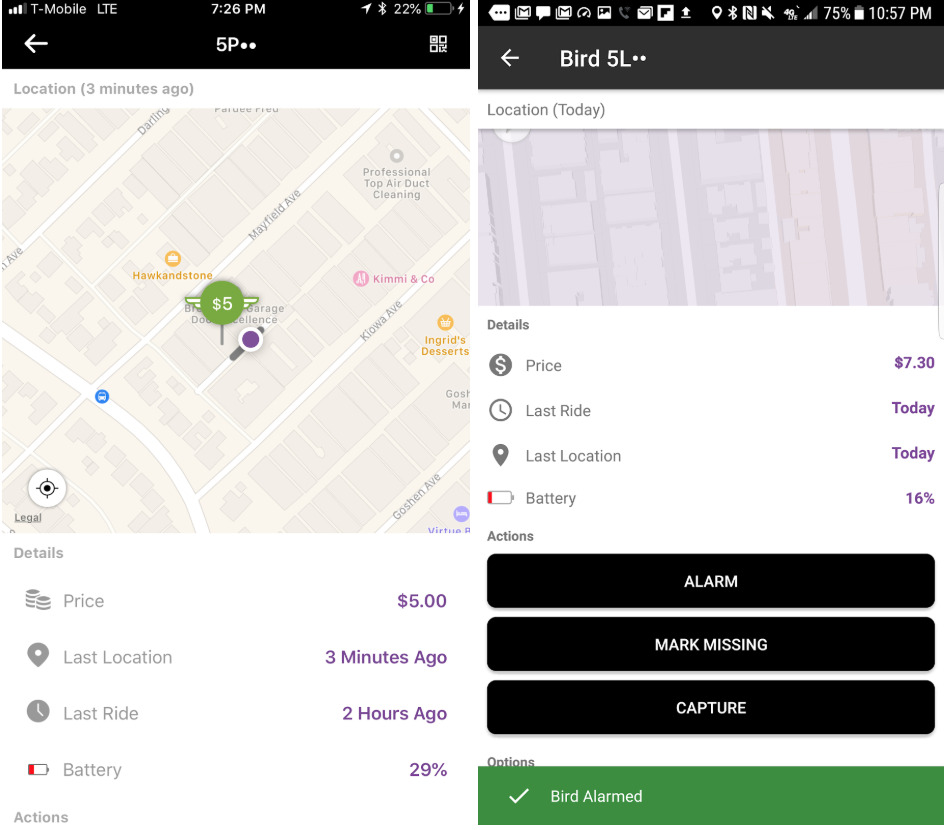
I’ve looked for Birds in a lot of places and at all different times of the day. And there’s one pretty clear indicator of how likely it is that I’ll find a Bird I set out to look for. That indicator is how recent the location and ride data is. The more recent the data, the more likely I’ll find the Bird.
What I love to see is a recent ride because that tells me it’s less likely the Bird is locked away in a rider’s or misbehaving Charger’s residence, which could be the case if a Bird had a recent location ping, but its last ride was long before. (We see you out there, hoarders! And we’re reporting you 🙂
Related Article: Bird Scooter Review on the exsplore adventure travel blog
PSA: What is “hoarding”? Hoarding is when Chargers, riders or even people with no relation to Bird keep many scooters locked away in a location. They may do this out of pure ignorance, but often with Chargers, it’s an attempt to manipulate the Bird’s value and it ends up wasting the time of the honest, hardworking folks who go to look for the Bird.
The app seems to be getting better at automatically identifying hoarding and NOT rewarding it, and I’m sure it’ll continue to improve because hoarding ultimately affects Bird’s bottom line. When I see a number of uncaptured Birds on the map and I can’t find them or I confirm they’re locked away, I just take a screenshot and send it to support. To contact support, tap HELP from the Charger menu.
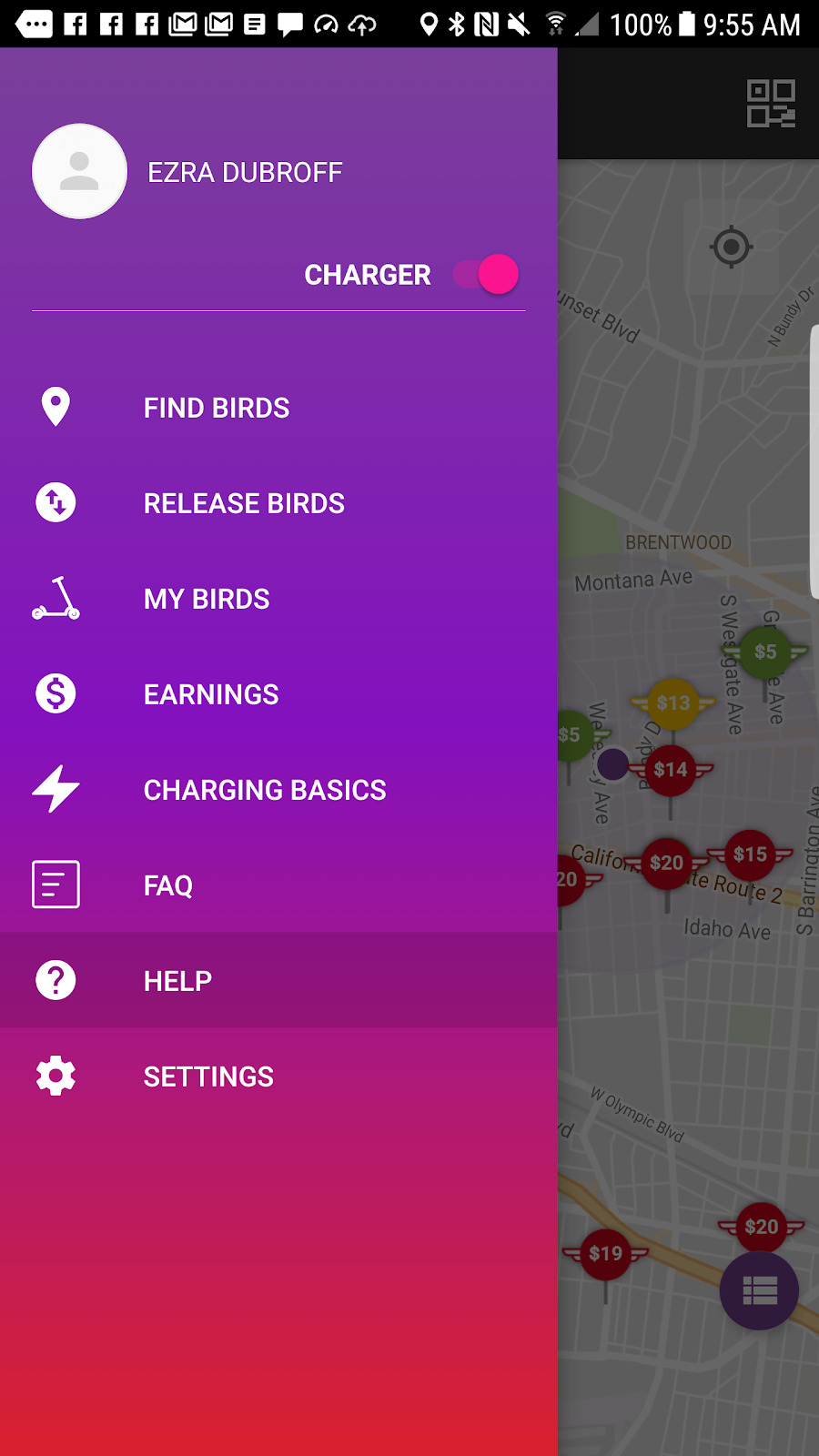
In addition to the ride and location data, I also like to zoom in on a Bird and see if it appears to be inside a building that I might not be able to access. Remember the map locations of the Birds are not always perfectly accurate. But when a Bird appears so far from the street like in the example below, that Bird is probably inside a building, which makes it much less likely I’ll be able to find it.
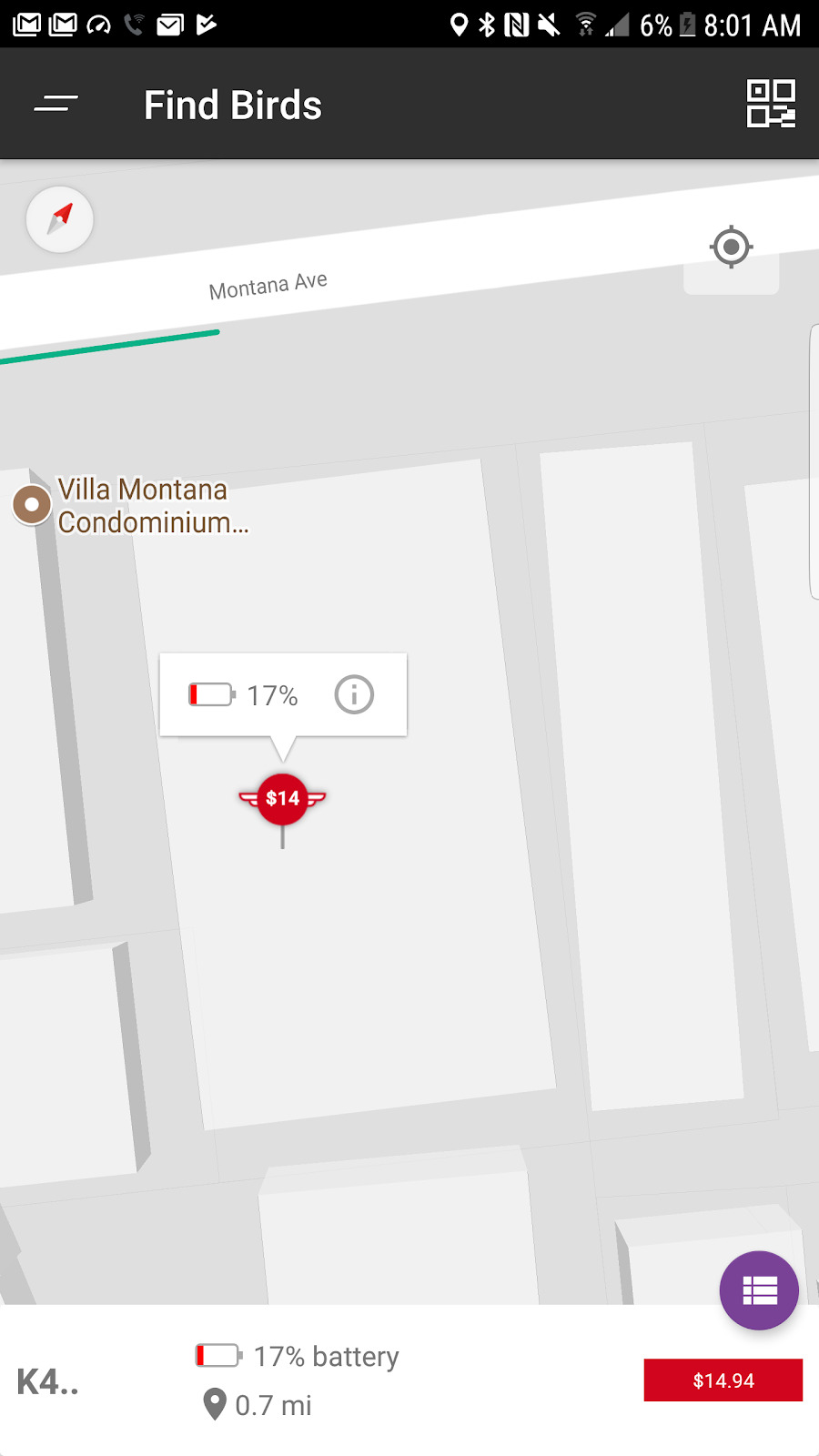
Being able to to match locations on the map with real-life knowledge of your local area will go a long way with helping you decide which Birds are worth looking for. You can always use Google Street View to check out a location before heading over.
Sometimes, Street View can tell you something that the map cannot, such as a location that is a gated lot with a high fence, probably not worth your time. Or maybe Street View shows easy access, in which case, go get the Bird!
Once I realized that I should focus on looking for Birds that are more “findable,” I started having a lot more success.
Want these tips in a handy checklist? Download our 10 Pro-Tips for New Bird Chargers below:
Where, When, How To Find Birds to Charge
For maximum efficiency and earnings, it makes sense search for Birds at times and in areas where we’ll have the most success in finding them, right?
To that end, let’s first consider that most Birds in need of a charge will likely be in or near a Bird service area. But how do you know where a service area is? There are not always clear borders and boundaries as Bird grows through cities, so one way to find out if Bird serves your area is to simply open the Bird Rider app and, if you see Birds available nearby, you’re probably in a service area.
You can also tap “Release Birds” from Charger Mode and view nearby Nests in the mornings (5-7 am). If there are Nests nearby, you’re also likely in a Bird service area. Bird is expanding quickly, so it’s a good idea to check the apps regularly for new service areas.
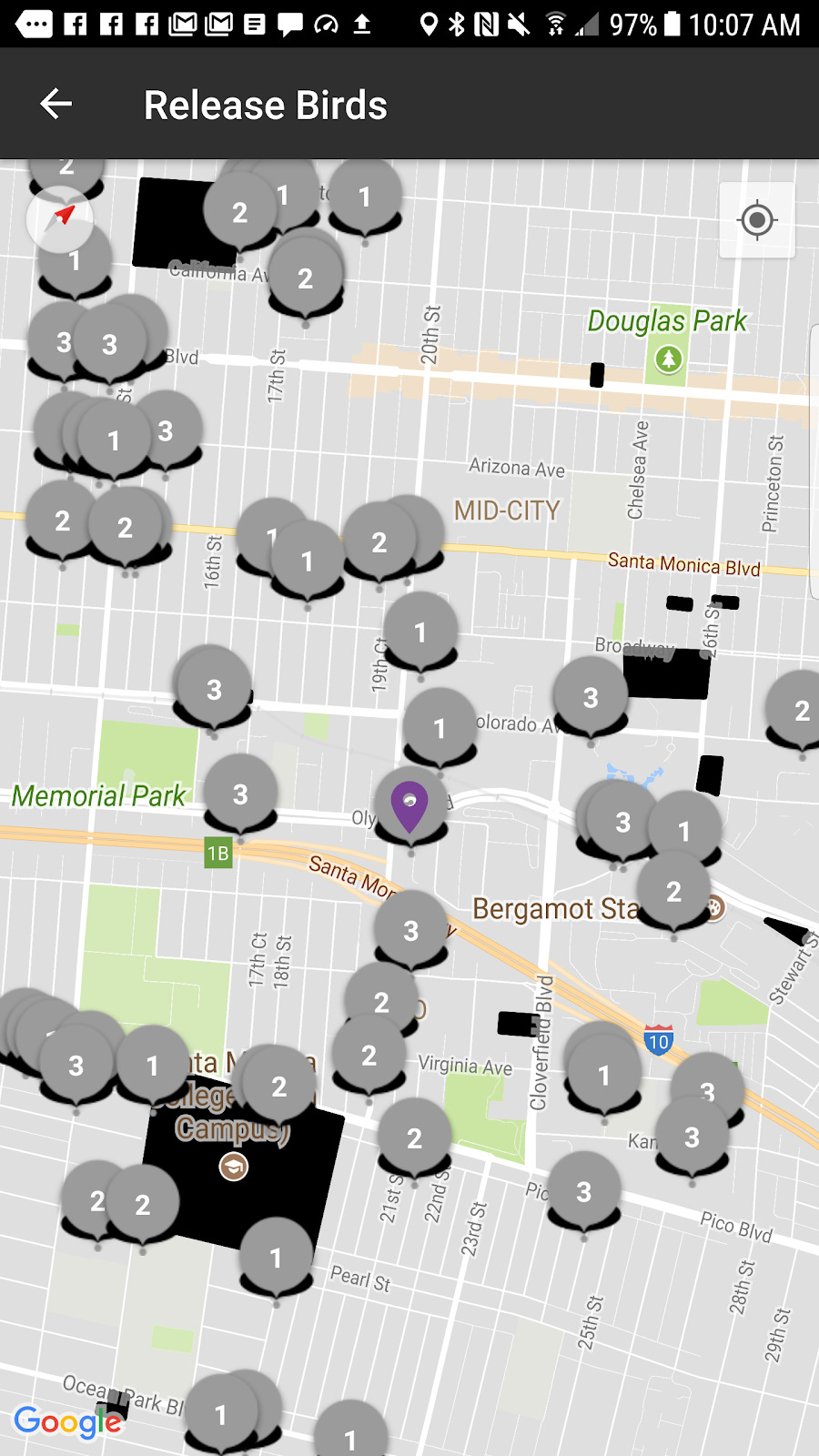
Now that we know to focus on a general area, let’s think about more specifically the best places and times to find Birds within that area. Different areas will present different opportunities and challenges at different times.
During the day, low-battery Birds will appear on the map as they become available to Chargers, but the best time to find Birds is at 9 p.m. when rides end for the day. That’s when most Birds appear on the map. Keep in mind that this could change if Bird changes their operating schedule.
Residential Areas: Many Birds will begin their days at Nests in residential areas. The overall trend in my area seems to be that people then ride those Birds into commercial areas to get to work. Riders also use Birds to get back home at the end of the workday. In many areas, residential neighborhoods will allow for the easiest Bird pickups, with wide streets and easy parking. The best times to find Birds in residential neighborhoods: end of the workday and 9 p.m. when rides end.
Commercial Areas: In commercial and downtown areas, you’re likely to see heavy Bird use throughout the day. Many people ride Birds to work every day. If there is nightlife in the area, this can heavy use can continue until rides end in the evening. Wherever there are a lot of people using Birds, there will be batteries running low and opportunities to pick up Birds throughout the day. Downtown areas can present some unique challenges in terms of parking and loading Birds into your vehicle. My tip: use those hazard lights and move quickly. I try to avoid parking illegally, but sometimes I’ll do it if I can quickly retrieve a Bird.
Campuses: In many ways, campuses are similar to commercial areas: Birds arrive in the morning for classes and go back to residential areas and transit stations later in the day. But we all know that there is no normal schedule or pattern of movement for a college student. So Bird availability on campuses can vary. Keep in mind that many college students are Chargers themselves so if you go to a campus, you may find yourself competing for Birds with some very bright, creative and resourceful people!
Charging Birds
Once I got a good handle on where and when to find Birds, I was ready for my next challenge: how to charge and release the Birds quickly and efficiently. Let’s remember that one power supply can only charge one Bird at a time and it can take up to 4 or 5 hours to charge a battery from 0%. (Though most Birds you find will not require a full charge from 0%.)
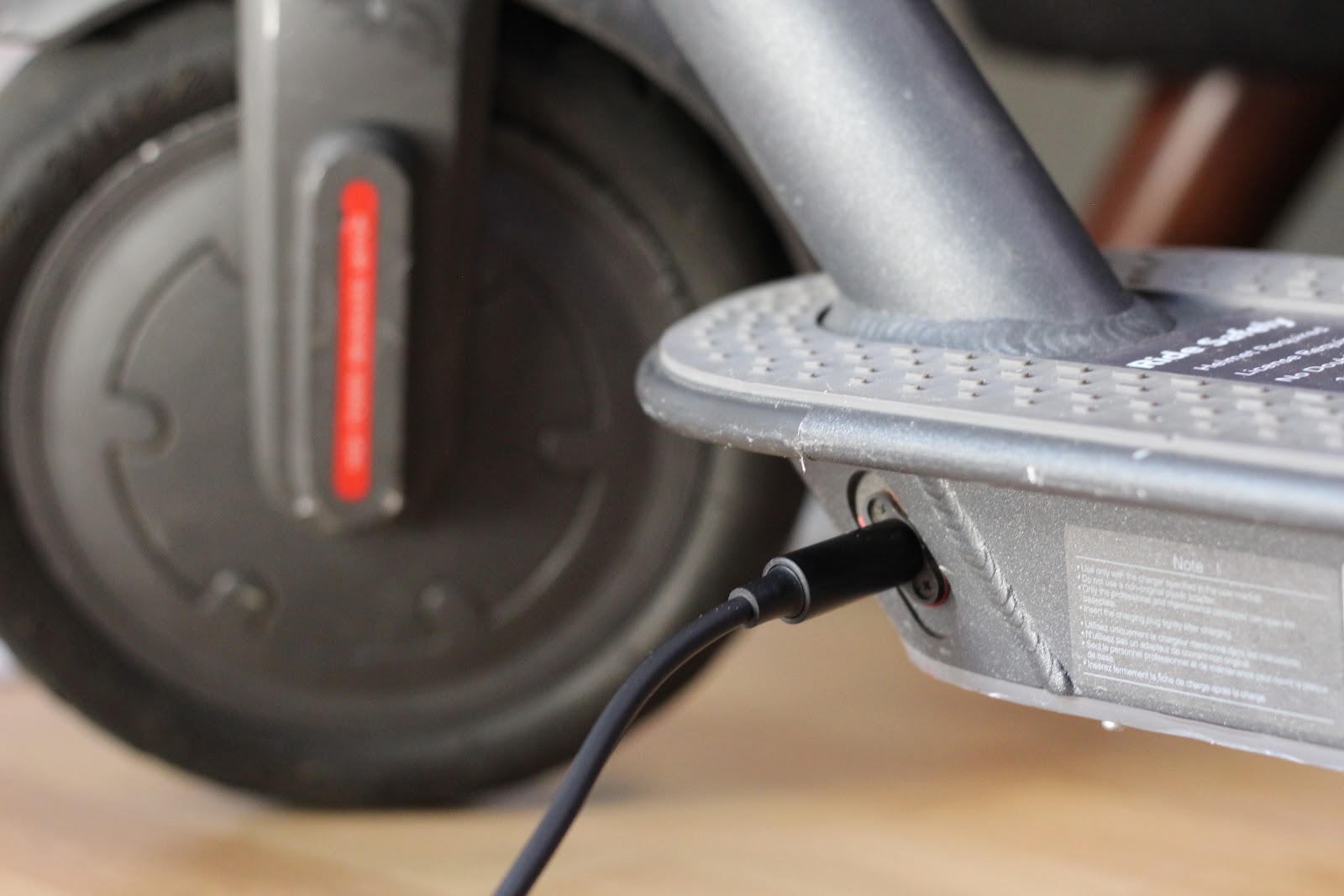
On one of my first days as a Charger, I found and charged 11 Birds using the 3 power supplies I had at the time. This required constantly moving Birds and swapping cables, including at 3 a.m. I soon realized that I couldn’t be waking up every night at 3 a.m. to swap cables, so I simply needed to get more power supplies.
Once you charge consistently for a few days, Bird will allow you to request additional power supplies so you can charge more Birds.
I requested and received more power supplies and that immediately made things so much easier for me. Now with 6 power supplies, I could find and capture 6 Birds, then just plug them in overnight to charge.
Your charging setup will depend on what’s available to you. Someone who has a truck to load a lot of Birds into and a garage to charge them in has a huge advantage in this business. But most Chargers won’t have those things. So why not get creative….
I live in an apartment, and even though it’s on the first floor, I quickly grew tired of carrying Birds in and out of my place. Not to mention, I didn’t like making noise so early in the morning and tracking dirt from the scooter tires onto my floor. So I decided I wouldn’t even bring them inside anymore.
When I pick up 6 Birds, I now load them in my car with the charging port facing up and in two groups of three. And when it’s time to charge my Birds, I don’t have to bring them inside, but instead I run an outdoor-rated extension cord to my covered car, where I can charge them overnight without moving them. In the morning, all I have to do is coil the extension cord back up and I can head out to drop off my Birds.
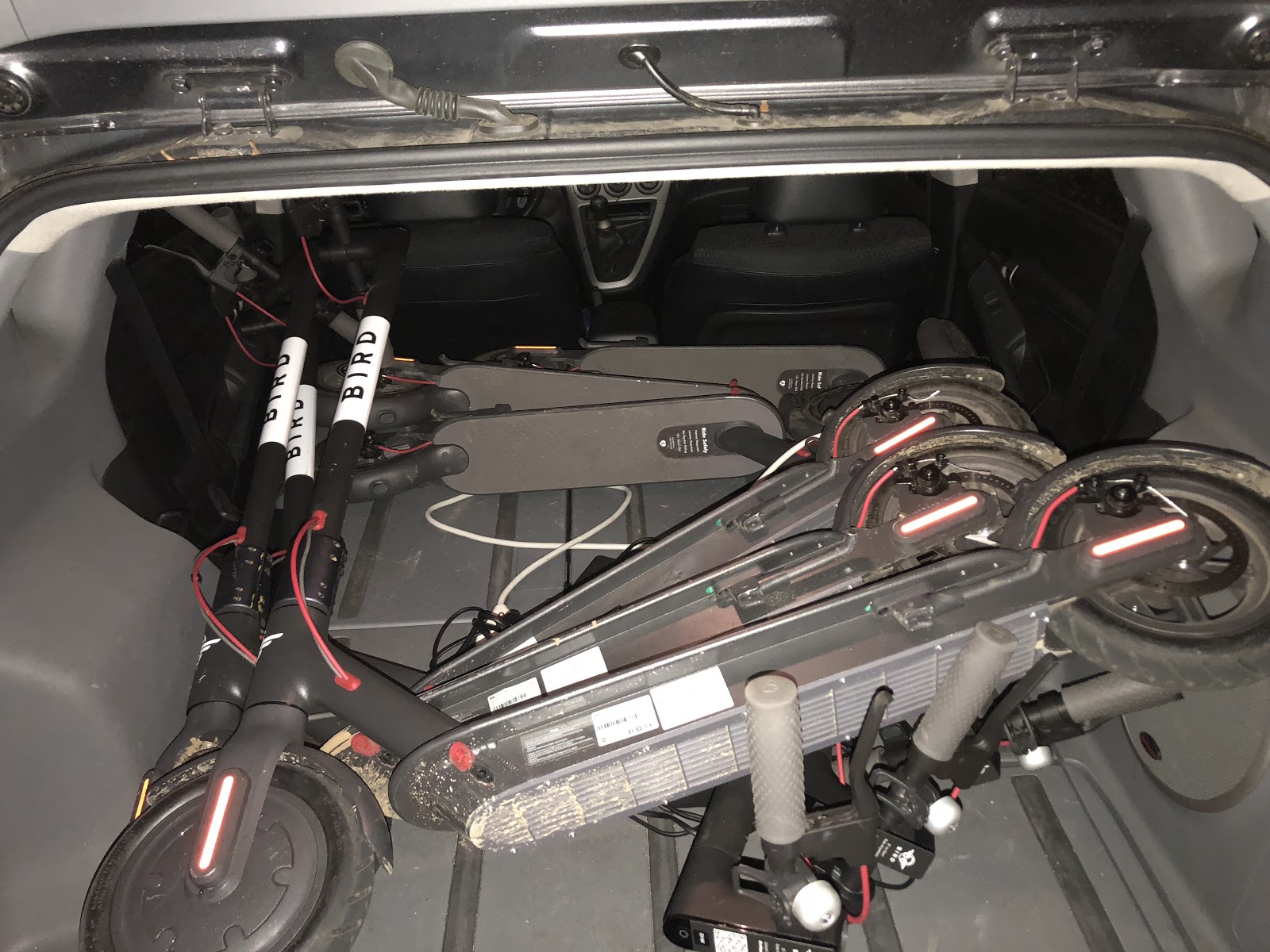
Keep in mind that this type of setup is not exactly sanctioned by Bird. They recommend you have an electrician perform an inspection. As independent contractors, we have little oversight though, so I’ve made the decision to charge my Birds in this way. I make sure to open the car windows as a precaution for extra ventilation.
Setting up a system has saved me so much time and effort because now when I find a Bird and load it into my car, it stays there I until I release it the next day.
Related article: essential gear every scooter charger should have
Releasing Birds after Charging
The only difficult thing about releasing your Birds is being awake before 7 a.m. That’s when all Birds should be in Nests and ready for riders to use. For some of us, waking up that early can be a challenge. Remember to allow extra time if you have to load your charged Birds into your vehicle before you head out and if you’re heading to Nests that require some time to get to.
Overall, releasing Birds is a pretty painless process, though. There’s little traffic at that time, nests are in known locations and, since we can drop multiple Birds at a single Nest, only a few stops are required. Because there are many Nests in my area, I can usually drop off six Birds between two Nests in about 10 minutes and be back home. Sometimes a Nest won’t be available in the app if another Charger has already reserved it, but in that case, I can just find another one nearby and head there.
Bird Charging Earnings & Expenses
Is finding, charging and releasing Birds worth the time and effort? Let’s take a look.
Over a period of several weeks, I tracked the values of 105 Birds I captured, charged and released. I also took some recordings of miles I drove and electricity I used in finding, charging and releasing Birds.
If you take a look at this earnings & expense spreadsheet I created, you can see that I was able to fully service each Bird (find, pick up, charge and release) in an average of just under 11 minutes, meaning that could translate to 5.46 Birds per hour.
And after deducting my vehicle expenses and estimated electricity usage, it looks like I was able to earn about $7.43 per Bird, which translates to a whopping $40.60 an hour AFTER expenses.
Now before we all go and quit our day jobs to become Bird Chargers full time, let’s keep some things in mind when looking at my earnings and the evaluating the potential opportunities out there.
- My effective average net hourly earnings of $40.60 sounds amazing, but for me was limited to just over an hour a day because I only had 6 power supplies and therefore I only usually charged 6 Birds per day. There are hustlers out there who are willing to do multiple charging cycles per day in order to charge more Birds than they have power supplies, but keeping track of battery levels and swapping cables throughout the day and night requires a lot more effort. Also remember that it’s generally more difficult to find Birds before 9 pm when rides end.
- The work involves 3 separate steps of finding, charging and releasing Birds and those steps are done at different times, so calculating hourly earnings can be tricky, but it’s certainly work that fits into a lot of people’s schedules.
- I did not keep full detailed mileage records so I’m basing my mileage and time numbers on an average of a sample of 24 Birds I found over 4 trips ranging from 19 to 62 minutes, each time capturing 6 Birds.
- Yes, I’m an idiot for not ALWAYS tracking my miles in order to get the maximum tax deduction.
Related: What Are the Best Apps to Track Your Mileage?
- I tracked the miles driven to get the Birds back to home base UNLESS I went to do something else instead of returning directly home.
- Average of 1.18 miles driven to find each Bird. Average of 7.21 minutes spent finding and collecting each Bird.
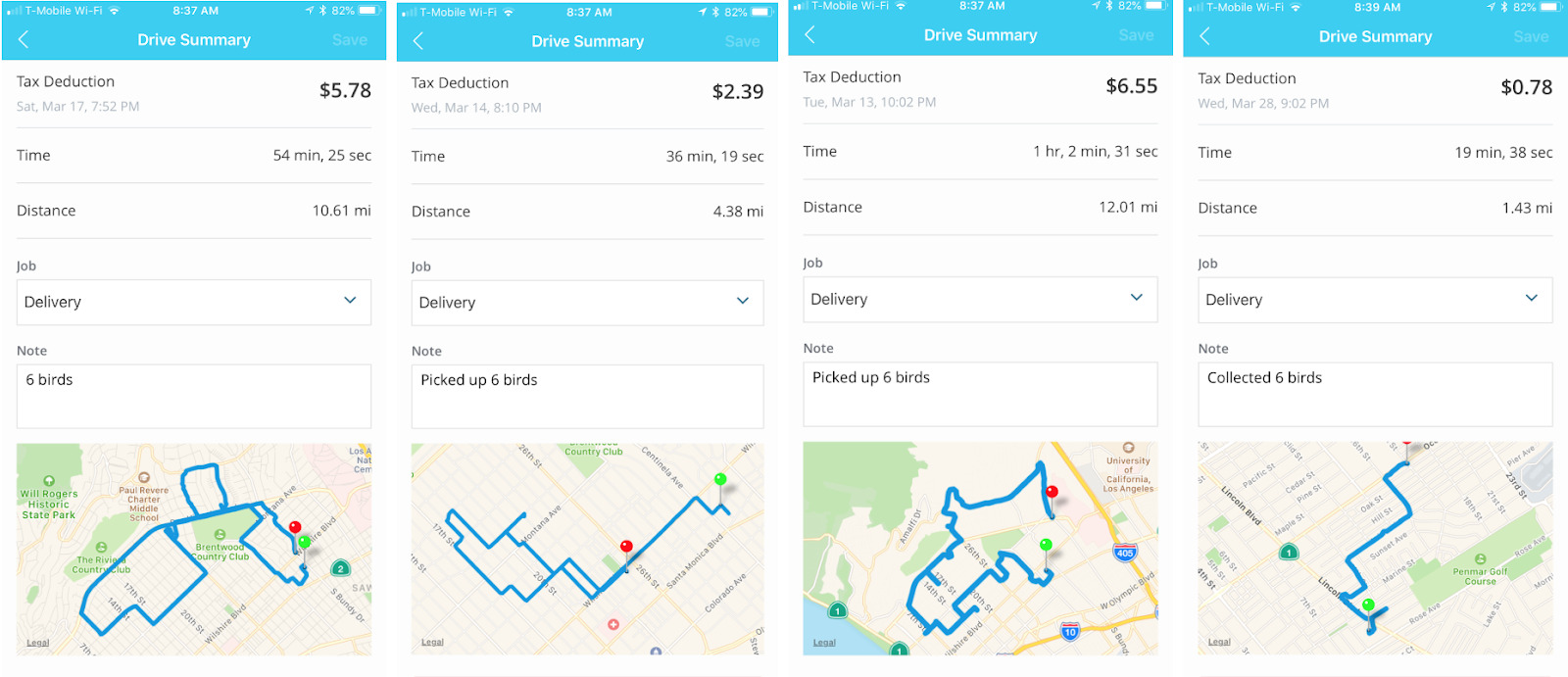
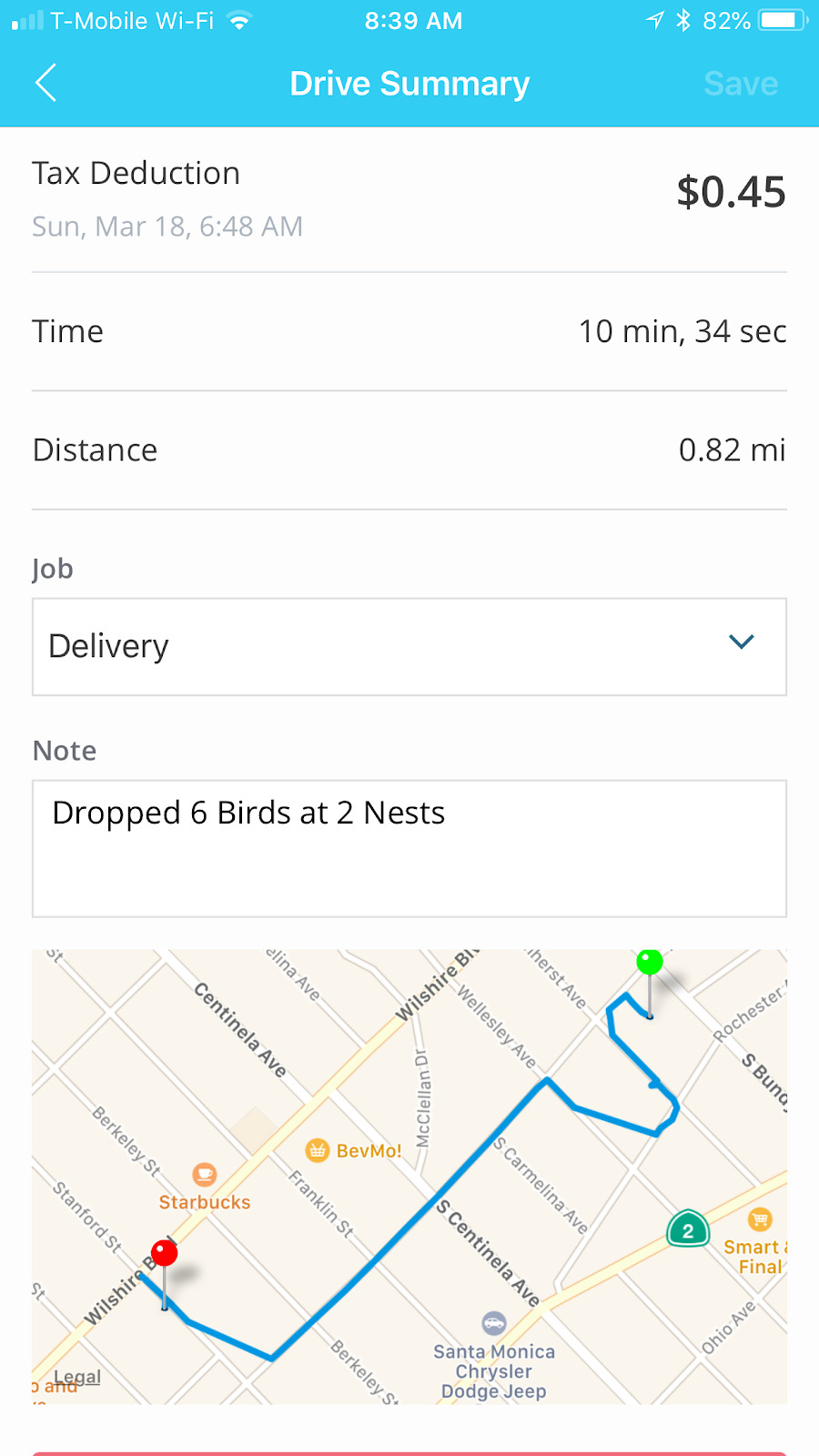
Most mornings, I released my Birds at two specific Nests and it usually took just about 10 minutes to complete the whole process.
- To track my electricity usage, I plugged into the Kill A Watt electric meter. This thing is pretty cool – it allows you to track energy usage from a particular outlet. I recorded total kWh used for charging 6 Birds on a number of nights, and recorded totals between 0.87 kWh and 1.89 kWh.
For the purpose of this spreadsheet, I chose to go with the highest possible energy use estimate of 1.89 kWh because on that night, I charged 5 Birds from an average of less than 2% battery to 100%.
Most Birds you find won’t have batteries as low as 0% and often they’re above 50%. So your charging time and electricity use would probably be much less.
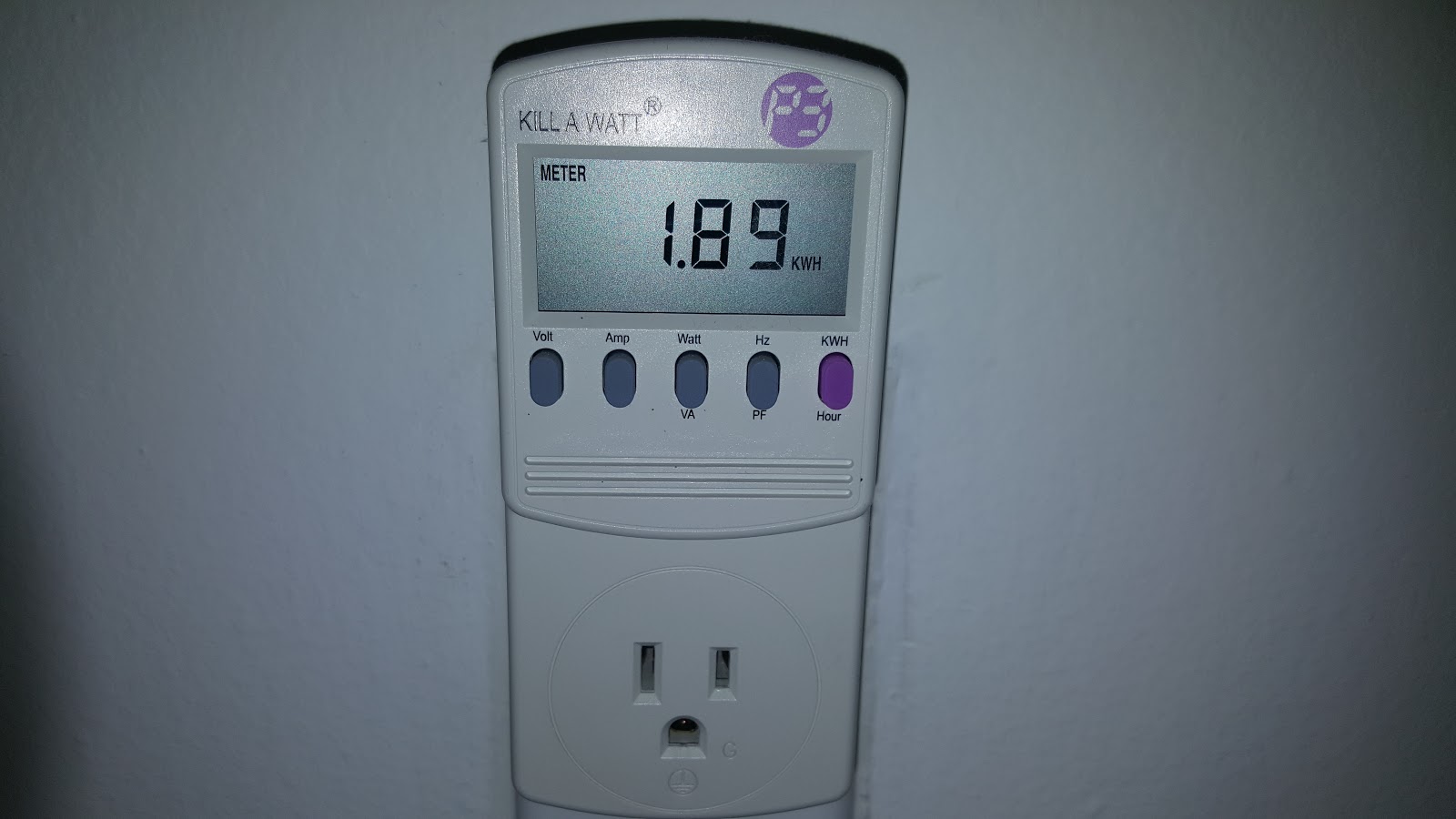
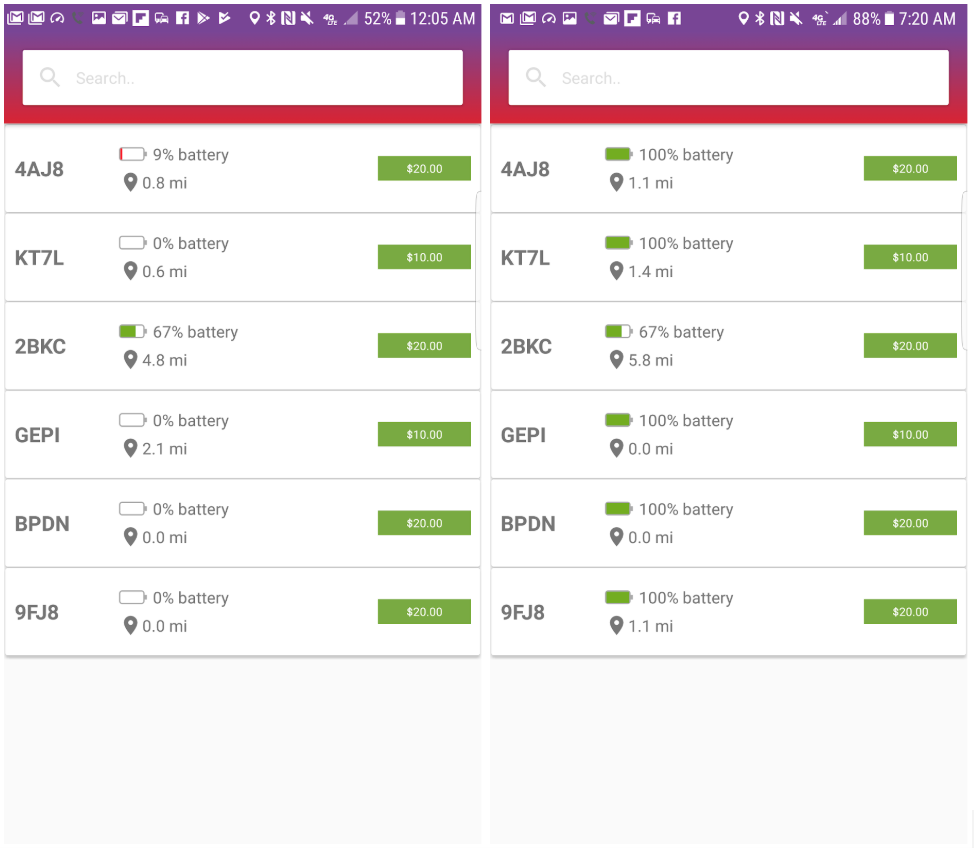
- Over a period of 3 months, my home electricity use cost me an average of $0.18 per kWh. Your utility rates may be different than mine and remember, you actually get billed at a higher rate if you go over certain thresholds. But the bottom line is it doesn’t cost much to charge a Bird — it costs me just about 7 cents per Bird to charge from 2% to 100%!
Looking at my individual Bird earnings, you may notice some payouts even lower than $3.00 and one as high as $40.00. When I first started as a Charger, some Birds would be valued at only $3 and I must’ve not charged it to 100%. Bird has since raised the minimum value to $5 in my market!
The $40 payout was a broken Bird that I was trying to return, but support gave me the wrong address at first and then hooked me up pretty nicely to make up for it. We can now drop broken Birds right at Nests so this situation probably won’t happen again for me.
Want these tips in a handy checklist? Download our 10 Pro-Tips for New Bird Chargers below:
Bird Charger Opportunities
When comparing being a Bird Charger to a rideshare or delivery driver, there are some interesting things to consider. If you’re giving rides or doing deliveries, the number of passengers or meals you can transport at a time is limited. But with Birds, you’re only limited by the size of your car, the place you charge and the number of power supplies you have.
Think about that — with the right tools, you could quickly scale your earnings in a way that’s impossible with other on-demand work currently out there. I’ve heard of Chargers who’ve made hundreds and even over $1000 in a day by scaling their operations.
You don’t have to choose to go all-in as a Charger though. There are some great opportunities to incorporate Bird charging into your already existing rideshare and delivery work and make some extra cash every day.
Just to give you some ideas:
- After giving rides in the evening, a driver could pick up Birds before heading home. The Birds could be charged overnight and released in the morning before giving rides again. The 7 a.m. Bird release time coincides perfectly with morning rush hour.
- Since delivery drivers don’t need room for passengers, they can pick up Birds while going about their restaurant pickups and deliveries. Simply keep the app open and grab any available Birds along your route. Just remember to keep some hand sanitizer with you if you’ll be switching between handling food bags and scooters.
If one thing is clear, it’s that Bird and its electric scooter app competitors are poised to make a big splash this year. As we’ve seen with the rise of rideshare apps a few years ago, it pays to get in early. And with Bird, there’s no cost to give it a try. My philosophy is that it’s always good to add another app to your rideshare “bullpen.”
Looking towards what the future holds for a Bird Charger, expect to see a lot of growth, a lot of changes and a lot more opportunities for workers to earn money in this sector. Happy charging!
Frequently Asked Questions
How much does Bird Scooter Pay?
Bird pays chargers $5-20 per scooter that is captured, charged and released by 7 am the next day. Green birds are the easiest to find and are usually available after 9 pm. Yellow and red birds are tougher to find but pay out more.
How do you download the app and become a charger?
Readers, is Bird in your city yet and, if so, would you consider becoming a Bird Charger? You can get a free ride with Bird here, sign up through the app in the Google Play or App store, and if you’re already a Charger, join the free Bird Charger community here.
-Ezra @ RSG
Join Our Forum
Where chargers share advice, tips, and tricks. Click here to join
Related Blog Posts:
- Essential gear for scooter chargers and mechanics
- Bird Charger review
- Bird Mechanic review
- How to plan your night as a Bird Charger
- The future of Bird
- Future of shared mobility
- Scooter Wars
Related Youtube Videos:
- What it’s like to be a Bird Charger
- Bird Charger app training & tutorial
- Bird Charger job review
- Bird scooter (company) review
- Bird Zero review (new scooter from Bird)
- Xiaomi M365 vs Segway ES2 (scooter review/comparison)

